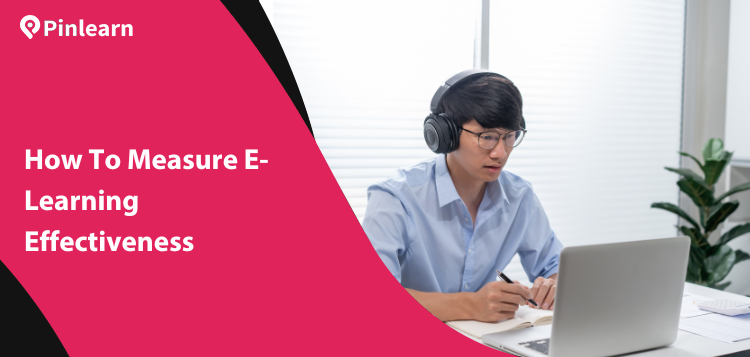How to Measure E-Learning Effectiveness: Methods, Metrics & Frameworks
Whether you’re an L&D manager or business leader, evaluating the direct impact of your learning program is essential. Curating a comprehensive course or training program doesn’t guarantee organizational success. Your program’s learning objectives must be aligned with business goals to drive results.
Collecting feedback from learners and other stakeholders ensures your program resonates with them. Additionally, the impact of your learning program depends on both knowledge retention and the application of on-the-job skills.
This blog examines the steps to measuring e-learning effectiveness, evaluation methods, and frameworks that drive business impact.
So, are you ready to empower your business towards long-term growth?
TL;DR
- Measuring the effectiveness of your e-learning program evaluates how well learning objectives are aligned with business goals.
- The right evaluation methods and learning frameworks offer data-driven insights to improve learning.
- Key quantitative metrics for evaluation are assessment scores, completion rates, time spent, knowledge retention, etc.
- Leverage surveys, questionnaires, interviews, and focus groups for qualitative feedback, such as learner satisfaction and progress.
- The Kirkpatrick model, Philip’s ROI model, and Kaufman’s Five Levels of Evaluation are among the most popular evaluation models.
- Assess business impact through ROI, on-the-job performance, and broader societal impact.
Why Measuring E-Learning Impact is Essential?
Here are the key reasons for measuring e-learning effectiveness:
-
Assess the Learning Performance & Effectiveness
Measuring whether your e-learning courses or training programs are aligned with your business goals. With the right metrics, you can measure the effectiveness of your training program in achieving outcomes.
-
Provides Data-Driven Insights
Evaluation methods, learning analytics, and tools offer data-driven insights to improve learning. Collecting qualitative and quantitative data on various aspects, such as engagement, learning outcomes, and feedback, helps significantly improve your content.
-
Demonstrate ROI
By evaluating the training cost against the benefits, you can determine the overall ROI of your e-learning program. A positive ROI indicates that your training is achieving its objectives, while a negative ROI means that your training needs to be worked upon.
-
Enhance Learner Engagement
Once you understand what’s working and what isn’t, you can make appropriate changes to improve learning efficiency. For example, to make courses more interactive, consider incorporating quizzes or gamification elements.
-
Improve Content Delivery
Tracking learning metrics like course completion rates, assessment scores, engagement, and UX issues ensures how well your learning goals are met. Accordingly, you can improve your content or design to enhance learning.
How To Measure E-Learning Effectiveness: 7 Effective Ways
To measure the effectiveness of an e-learning program, you need to pick the right learning objectives, methodology, metrics & strategies. The methods & roadmap differ significantly depending upon whether you’re evaluating an e-learning course content or an employee training program.
Here are 7 easy steps to measuring e-learning effectiveness:
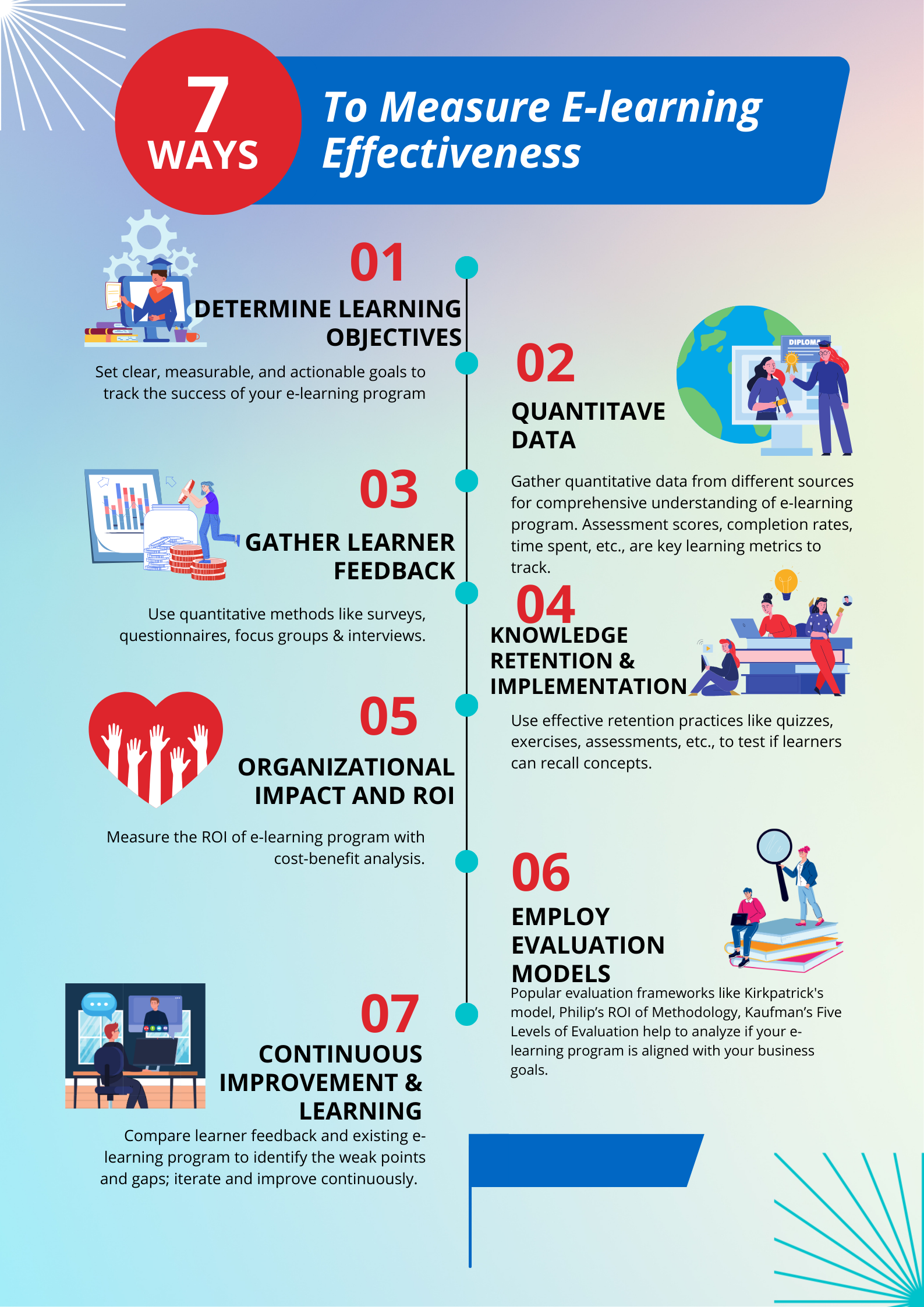
Step 1: Determine Learning Objectives
The first step is to set clear, measurable, and actionable goals to track the success of your e-learning program. Essentially, this involves laying out the purpose of your e-learning program.
Every course or training program has a definite purpose. Identifying the end goal makes it easier for learners & educators to lay the right strategies & metrics for measuring the effectiveness of your e-learning program.
Here are different kinds of objectives you can assess:
- Knowledge – Have learners gained essential knowledge for their task?
- Skills & Implementation – Does the e-learning program offer the required skills for the learner’s progress?
- Behaviour & Engagement – Are there any significant behavioural changes (like application on job and participation in discussion forum)?
- Business Impact – Is there any significant improvement in ROI or other organizational goals?
Step 2: Collect Quantitative Data from Different Sources
Next, track different metrics based on your learning objectives. Gathering quantitative data from different sources provides a comprehensive understanding of the effectiveness of your e-learning program.
Key Learning Metrics for Effective Evaluation:
- Assessment Scores – Incorporate quizzes, tests, assignments, or skill demonstrations to measure how well learning outcomes are met.
- Completion Rates- Shows the percentage of learners completing the e-learning course or training program. A high completion rate indicates a better engagement rate, while a low completion rate implies that the content needs improvement.
- Time Spent – When a learner spends more time on a specific module, it means either they find the section engaging or challenging. It is measured by frequency of login, session duration and course interaction.
- Knowledge Retention Rate – This measures how much information or skills learners can recall once they complete the learning program. Quizzes & assessments after completing each module or chapter help to gauge learner retention.
- Skill Application Metrics – If your e-learning program involves skill training, assessing on-the-job application is essential. This typically involves evaluating the skill progression before and after training.
Step 3: Gather Learner Feedback
Learners are the most essential stakeholders of your e-learning program. Hearing it straight from the horse’s mouth makes it more relevant!
While assessment scores and time spent reveal half the story, qualitative data gets direct feedback from learners. Learners have first-hand experience with your e-learning program, hence they can offer valuable feedback to enhance your program.
For example, for an L&D training program, qualitative feedback reveals employee performance, satisfaction, skill gap coverage, and on-the-job skill application.
Key Qualitative Feedback Methods :
- Surveys & Questionnaire – Include a mix of open-ended, multiple-choice, and Likert scale questions. Feedback makes your learning program more relevant and well-aligned.
- Interviews & focus groups – 1:1 interviews capture first-hand experience of learners with course design and delivery. A focus group is more effective than surveys as it provides summative and formative feedback.
Furthermore, the kind of questions you ask also matters! Include clear questions that help you gauge learner satisfaction and progress. Additionally, ask a mix of open and closed-ended questions.
For instance, you could start with questions like:
- Did you find the course or training program engaging?
- Were the instructions clear & direct?
- How well did the e-learning program meet your learning goals?
- Did you gain valuable insights and skills? How well can you apply it on the job?
After collecting feedback, analyze their responses. Your quest for an improved learning program begins now!
Assess whether your program is up to the mark and meets learner goals and expectations. Enrich your content, incorporate activities, or try a different format to resonate better with your learners.
Step 4: Assess the Knowledge Retention & Implementation
Although your e-learning program might score high on engagement, learners might find it challenging to recall what they learnt. Hence, it’s important to have effective retention methods in practice.
For example, training programs could include module-wise quizzes, assessments, or exercises to test knowledge and skills. Emulating real-world work scenarios in the assessment helps organizations to gauge how well learning sticks!
Another thing to consider here is the reduced attention span of learners. 70% of learners forget what they learnt through the course within a day or two. This emphasizes the importance of ongoing assessment between the learning modules. The results often point out the strengths and potential gaps in your learning program.
Bite-sized learning modules, storytelling, interactive activities, repetition through role-play and simulations are common retention strategies.
Step 5: Track the Organizational Impact and ROI
Once you have collected baseline data on skill gaps, you can easily measure the ROI of your learning program. Assessing your e-learning program in terms of operational performance is quite essential.
For this, you could calculate the development cost of your training program and compare it with the gains in employee and partner performance.
Consider a company that invests $60,000 in training & development. Post-training, they notice an astounding ROI of 200%, which is quite impressive. So, this means every dollar invested provides a worthy return!
Here’s how you can measure the ROI of an e-learning program:
- Set clear learning objectives for measuring the training program’s ROI
- Calculate all training costs: subscriptions, software licenses, equipment, etc.
- Measure pre and post-training of your internal and external teams, capturing essential metrics like knowledge retention, error rates, etc.
- Include intangible and long-term benefits, employer engagement, retention rates, etc.
Step 6: Apply Evaluation Frameworks
Once you have set your learning goals, choose your evaluation framework. Of course, there are several ways to evaluate your e-learning content.
Here are some well-known learning evaluation frameworks:
Kirkpatrick’s model
Kirkpatrick’s model is a globally used framework for evaluating e-learning programs. It can be used to evaluate informal and training programs.
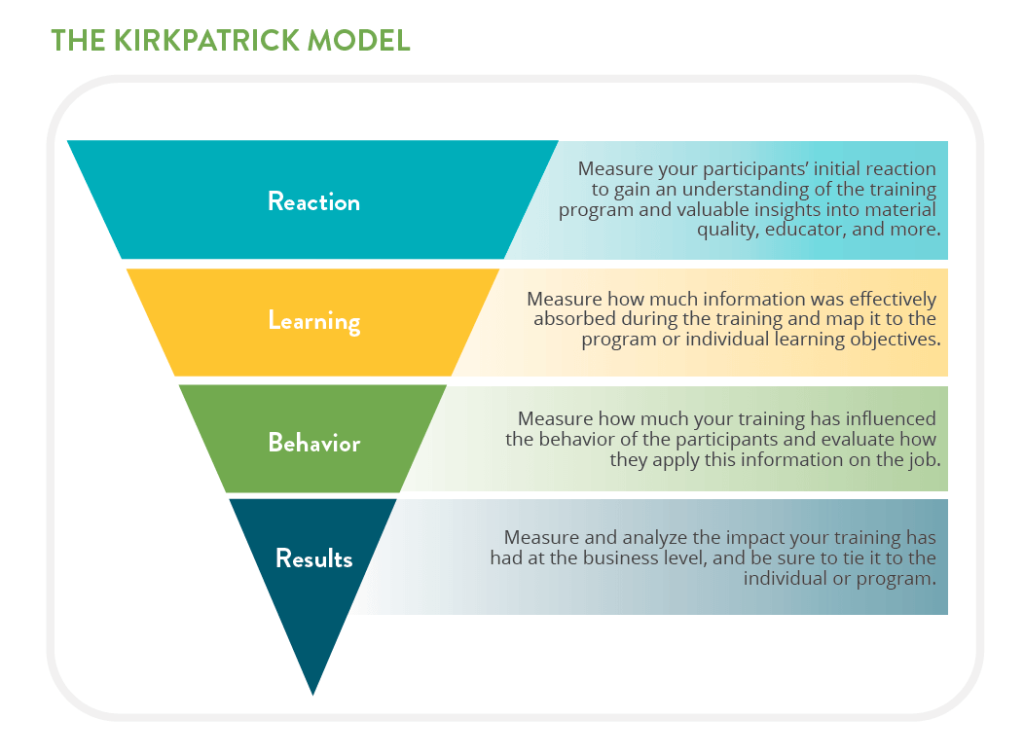
The four progressive levels for evaluation are: reaction, learning, behaviour, and result. Let’s understand each of them briefly.
- Reaction or Level 1 – Organizations collect learner feedback through surveys and feedback forms.
- Learning or Level 2 – Evaluating knowledge & skills gained through tests or assessments.
- Behaviour or Level 3 – Measure how effectively learners apply what they have learnt. This involves assessing behavioural change through performance metrics and observation.
- Results or Level 4 – The last stage is to assess the effectiveness in terms of organisational or business outcome. ROI, increased sales, or reduced error rates are a few performance metrics.
Philip’s ROI of Methodology
Another modern evaluation framework that builds on Kirkpatrick’s model is Philip’s ROI methodology. It adds an additional fifth layer of calculating ROI to the popular Kirkpatrick model.
It basically demonstrates the effectiveness of the learning program in terms of cost-benefit analysis. Organizations can compare the overall monetary cost of training with the business impact.
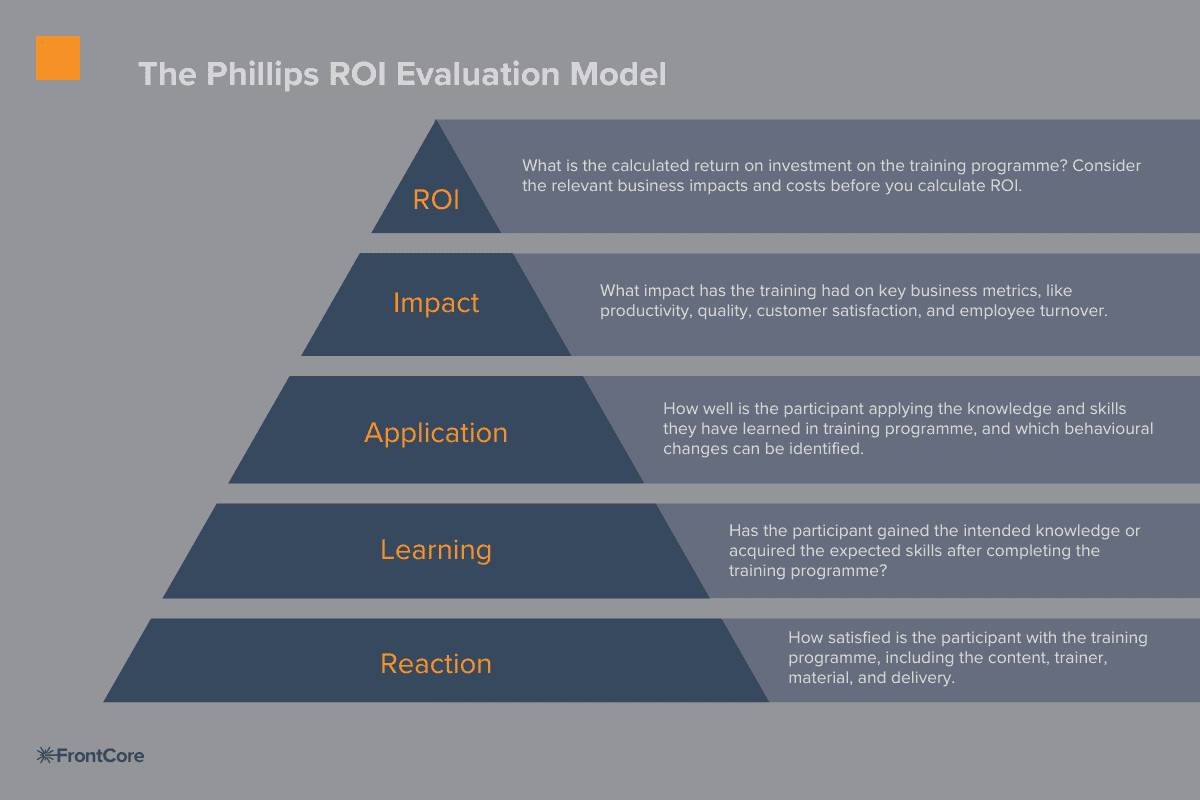
ROI (%) = (Net Program Benefits / Program Cost) x 100
This provides solid evidence to managers and organizations about the effectiveness of training programs.
Kaufman’s Five Levels of Evaluation
Yet another learning framework built on the Kirkpatrick model, Kaufman’s learning framework measures the broader impact of your program. The model adds input, process evaluation and societal outcome to Kirkpatrick’s model.
It measures the societal impact of your training program beyond mere organizational goals.
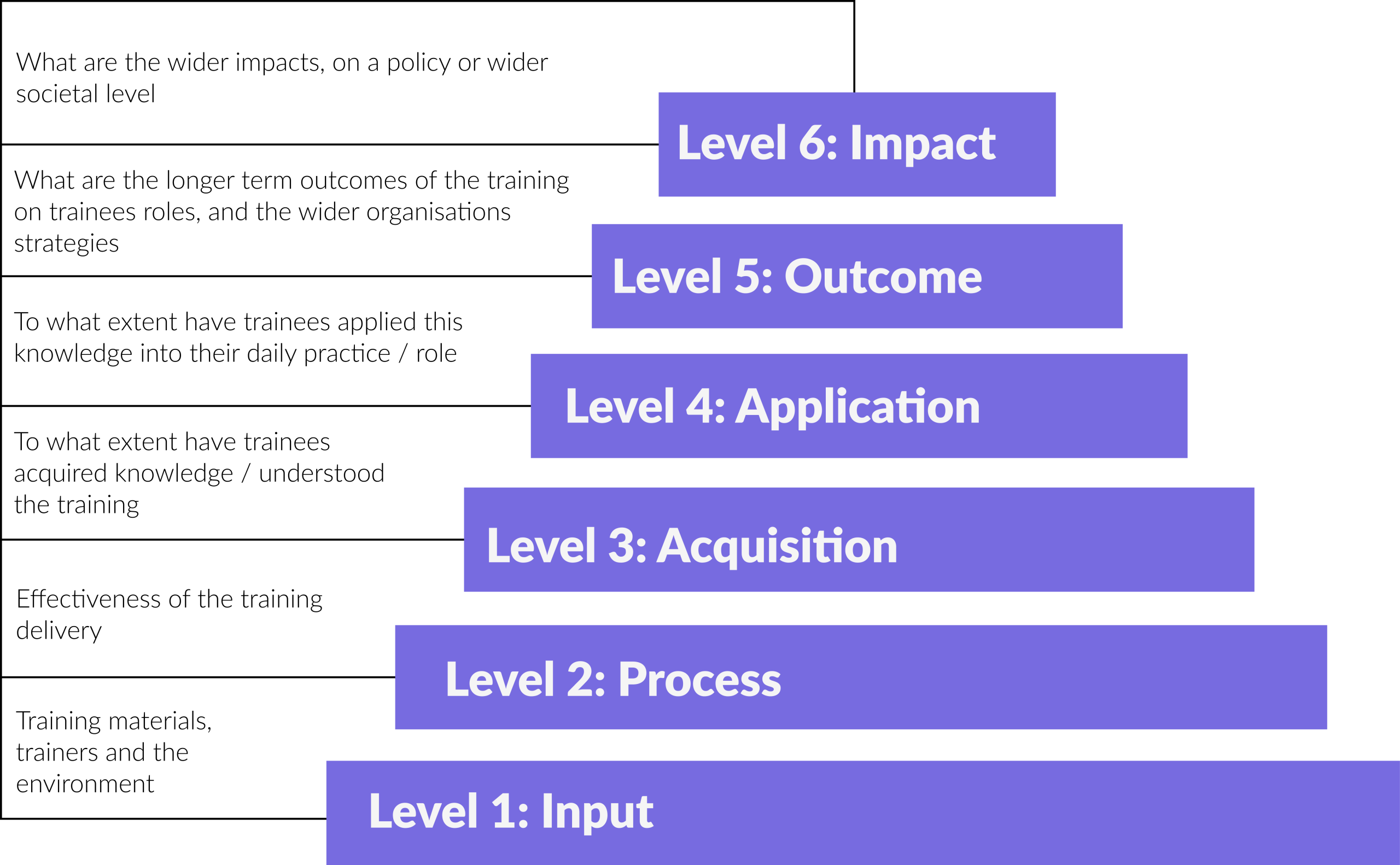
Here are the five levels of Kaufman’s Model:
- Input or Level 1a – The training materials and resources to support employee training programs.
- Process or Level 1b – Evaluates the actual learning experience or acceptability of the training program.
- Acquisition or Level 2 – Understands whether learners acquire the learning and are applying it on the job.
- Application or Level 3 – Determines how effectively learners apply what they learnt on the job.
- Organizational Outcome or Level 4 – Evaluates the cost-benefit analysis for the organization as a whole.
- Societal Outcome or Level 5 – Measures the mega-level client or larger societal benefits of the training program as a whole.
Besides, modern learning analytics & xAPI technologies offer sophisticated measurement and insights to make data-driven decisions.
Step 7: Aim for Continuous Improvement & Learning
Reviewing and evaluating your learning program is an ongoing process. Collect learner feedback and refine your course or training content. There are several evaluation methods & tools, constantly exploring what works best for your content.
Measure the effectiveness of your e-learning program across diverse markets, languages, and learning goals to effectively scale your program. Collect valuable feedback on design, delivery, and operational impact of your learning program; constantly iterate to improve the effectiveness.
Most importantly, improve your learning program with the evolving needs and expectations of learners.
Conclusion
Measuring the overall effectiveness of an e-learning program helps to understand if your efforts are streamlined in the right direction. When you align your learning objectives with business goals, you accelerate growth and aim for continuous improvement.
Gather feedback across different strategic points of your learning program to gain a comprehensive understanding of your learning program. Nurture learning experiences that translate into business impact & contribute to the long-term organizational vision!
FAQ-Related of Measuring E-learning Effectiveness
1. What is the role of learner feedback in measuring effectiveness?
Learner feedback provides valuable insights into learner satisfaction, learning gaps, and boosting training productivity. It helps to improve the overall learning experience in terms of learning content, usability, or student communication.
2. What are the key metrics to track to improve learning effectiveness?
Here are the essential metrics for improving learning effectiveness:
- Learning Engagement
- Learning Outcome
- Satisfaction and Feedback
- Training ROI
- Completion Rate
- Assessment Score
- Knowledge Retention
3. How can e-learning be evaluated?
E-learning can be evaluated in the following ways:
- Questionnaires, polls, and satisfaction learner surveys
- Pre and post-performance skill assessment
- 360-degree feedback mechanism
- Interview and focus group
- Learner tools & analytics
- On-the-job performance monitoring

